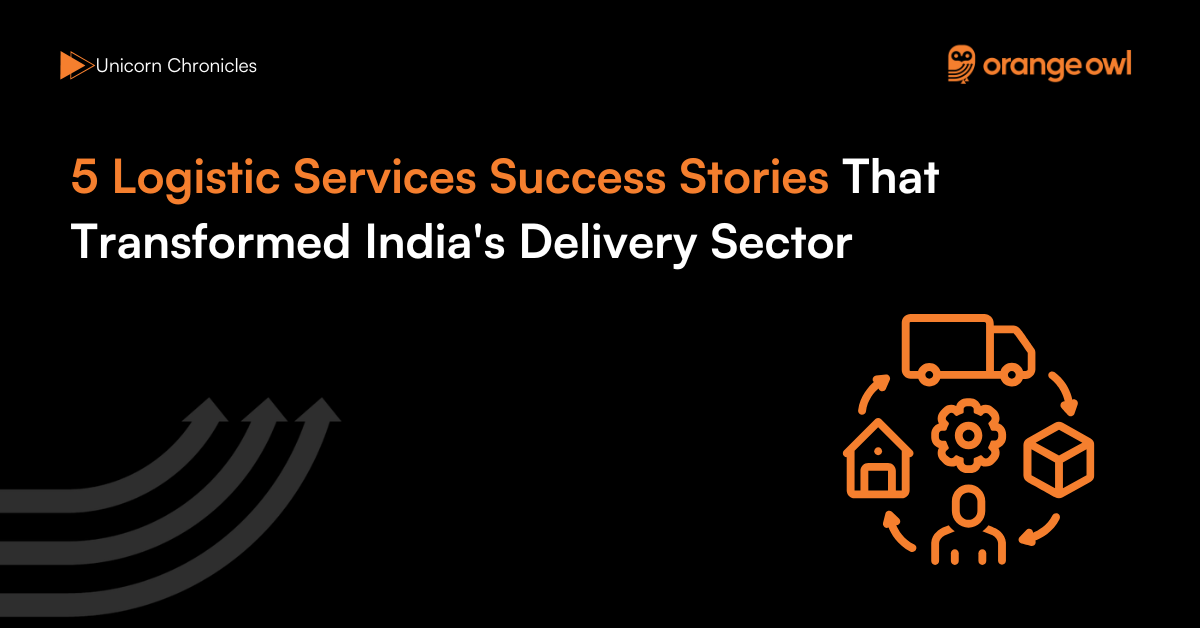5 Logistic Services Success Stories That Transformed India’s Delivery Sector
Vivek Goel
June 14, 2025

Table of Contents
Introduction
The logistics industry forms the very backbone of a country’s commerce — it’s the silent force that connects businesses with their suppliers and consumers, moves products efficiently across vast geographies, and plays a key role in strengthening a thriving economic ecosystem.
Without a robust and reliable logistics network, companies struggle to get their products into the hands of their customers on time, inventories pile up, delivery timelines suffer, and the overall health of the market hangs in the balance.
In a country as large and diverse as India, this challenge is even more pronounced. The need to seamlessly connect countless businesses — from small kirana stores in villages to large enterprises in metropolitan centers — has opened up a unique opportunity for innovators to transform the industry. It’s a space filled with bottlenecks and inefficiencies, but also rich with potential for those who can find clever, scalable solutions.
The stories of XpressBees, ElasticRun, BlackBuck, Rivigo, and Delhivery showcase how companies can innovate, solve bottlenecks, and scale operations by understanding their industry profoundly and applying technology in clever ways. Each of these companies challenged the traditional delivery models and leveraged technology, collaboration, and adaptability to streamline operations and empower businesses across sectors.
Here are the key lessons we can learn from these companies’ journeys — lessons that can help aspiring entrepreneurs navigate their own path toward success. From designing scalable delivery networks to unlocking hidden potential in the ecosystem, these stories illuminate strategies that can drive growth, cut inefficiencies, and create lasting value in a rapidly-changing industry.
1️⃣ XpressBees Success Story: 5 Growth Lessons for Entrepreneurs
About:
Originally founded in 2015 as the logistics arm of FirstCry — India’s leading online baby and kids’ products retailer — XpressBees soon struck out on its own, growing into a dominant, technology-centric, full-stack logistics provider.
Today, it handles everything from first-mile delivery to last-mile distribution across sectors, serving businesses of all sizes and delivering countless packages every day. Using a combination of sophisticated technology, extensive delivery networks, and strong operational expertise, XpressBees successfully transitioned from a specialized service provider into a scalable, multi-sector powerhouse — a true leader in India’s growing logistics industry.
Key Lessons:
✅ Embrace technology:
XpressBees leveraged automation, data, and sophisticated routing algorithms to streamline operations across its extensive delivery network. By optimizing delivery schedules and routes, it cut delivery times and operational costs, making its service more efficient and reliable.
✅ Develop scalable delivery models:
From lightweight parcels to heavy goods, XpressBees designed specialized delivery solutions to handle different segments effectively. It recognized that a “one-size-fits-all” approach wouldn’t work in a country as large and diverse as India.
✅ Expand service lines:
Originally a delivery service for a single client, it quickly expanded its capabilities to become a multi-sector, multi-customer powerhouse — serving businesses across retail, pharmaceuticals, food, and more.
✅ Leverage partnerships:
Collaborative partnerships with businesses, vendors, and delivery partners multiplied its reach without the need to own all resources directly. By outsourcing components of its operations, XpressBees remained asset-light and adaptable.
✅ Stay adaptable:
The ability to respond quickly to changing market conditions — whether it’s growing delivery volumes during a festive season or developing specialized services for a new industry — made it a preferred delivery service across sectors.
2️⃣ ElasticRun Success Story: 5 Essential Lessons for Entrepreneurs
About:
ElasticRun challenged the traditional distribution chain by using an asset-light approach. It teamed up with small grocery stores — called kiranas — to create a vast delivery network across India’s remotest villages.
By integrating these neighborhood stores into its ecosystem, ElasticRun turned their physical locations into delivery points, reducing delivery costs and extending reach into previously underserved areas.
This unique approach not only opened up a huge market opportunity but also supported the growth of small businesses by adding additional income streams for participating kiranas.
Key Lessons:
✅ Identify a unique bottleneck:
ElasticRun recognized that many small businesses were cut off from main distribution networks due to poor infrastructure and a lack of delivery resources in rural areas.
✅ Leverage existing resources:
Instead of building its own delivery network from scratch, ElasticRun turned neighborhood stores into delivery points, efficiently utilizing their physical locations.
✅ Design scalable technology:
The company’s platform efficiently routed orders and deliveries across this vast network, optimizing delivery schedules and reducing delivery latency.
✅ Support stakeholders:
Small store owners earned additional income by participating in the delivery network, making ElasticRun a win for all — businesses, delivery providers, and consumers.
✅ Reach underserved markets:
ElasticRun opened up a previously neglected market — the rural last-mile — in a scalable, cost-effective way, unlocking significant growth potential for both itself and its ecosystem of small businesses.
3️⃣ BlackBuck Success Story: 5 Insightful Lessons for Entrepreneurs
About:
BlackBuck transformed India’s fragmented trucking industry by developing a digital platform to connect shippers directly with truck owners.
Traditionally, this industry was filled with middlemen and inefficiencies — many trucks remained under-utilized or idle due to poor visibility and match-up of demand and supply.
Using technology, BlackBuck successfully removed these bottlenecks and provided a scalable solution to match the right load with the right vehicle in real time.
Today, BlackBuck plays a key role in optimizing India’s logistics chain — improving profits for vehicle owners and delivery timelines for businesses — while strengthening the ecosystem through financial services and vehicle maintenance.
Key Lessons:
✅ Identify a clear pain point:
BlackBuck addressed a longstanding industry challenge — poor visibility and pricing transparency — that kept trucks from being efficiently utilized.
✅ Create a scalable match-up platform:
Using technology, BlackBuck efficiently connected supply and demand across regions through its digital platform, reducing idle time for trucks and cutting delivery inefficiencies.
✅ Remove middlemen:
By cutting through a multi-layered ecosystem, BlackBuck made transactions more efficient, profitable, and reliable for both vehicle owners and businesses.
✅ Leverage data:
BlackBuck analyzed delivery patterns and pricing trends to match resources more accurately and make smarter decisions about pricing and routing.
✅ Add additional services:
Using its platform, BlackBuck was able to provide financial services, vehicle maintenance, and other support — strengthening loyalty and adding additional revenue streams.
4️⃣ Rivigo Success Story: 5 Powerful Lessons for Entrepreneurs
About:
Rivigo challenged the industry’s conventional delivery model by employing a relay system — a dramatic departure from the decades-old practice of having a single driver stay on the road for days.
Instead of putting all the pressure on a single person, Rivigo divided journeys into segments. Drivers would drive a predefined route, pass on their truck to another driver, and then return home the same day.
This relay model not only cut delivery timelines nearly in half for many routes, but it also improved the lifestyle and well-being of drivers — allowing them to be with their families daily instead of staying away for extended periods.
Using sophisticated algorithms and real-time data, Rivigo routed journeys efficiently and maintained service consistency across its vast network.
Key Lessons:
✅ Challenge the status quo:
Rivigo challenged a decades-old delivery practice to find a more efficient way forward. It addressed deep-rooted inefficiencies by thinking outside the box and designing a relay system from scratch.
✅ Design for people:
It addressed a key industry bottleneck — driver lifestyle — by improving their health, happiness, and retention, which in turn enhanced service delivery and lowered attrition.
✅ Leverage technology:
Rivigo’s algorithm efficiently routed journeys and managed relays in real time. It used data to match the right driver to the right leg of the journey, optimizing delivery schedules.
✅ Boost delivery speeds:
The relay model cut delivery time nearly in half for many routes, offering a powerful unique selling proposition (USP) to clients who demanded faster delivery.
✅ Scalable and adaptable:
The technology-assisted relay can be applied across sectors, geographies, and delivery segments. It’s a scalable solution that grows alongside the business.
5️⃣ Delhivery Success Story: 5 Crucial Lessons for Entrepreneurs
About:
Starting in 2011, Delhivery grew from a single-customer delivery service into India’s largest fully integrated logistics provider. It now handles everything from express parcels to heavy-freight and specialized delivery services across sectors — e-commerce, healthcare, automotive, and more.
Using sophisticated technology — routing algorithms, warehouse automation, real-time visibility — Delhivery transformed its operations from a small delivery venture into a scalable, enterprise-grade delivery network.Today, it plays a key role in strengthening India’s delivery ecosystem, offering flexible services tailored to different sectors and delivery requirements.
Key Lessons:
✅ Start small and specialize:
Delhivery first mastered delivery for e-commerce companies in Delhi. By focusing on a small market first, it was able to streamline its operations and develop expertise.
✅ Slowly broaden services:
Once it mastered a niche, Delhivery leveraged its expertise to move into heavy-freight, B2B delivery, and specialized segments — adding depth and revenue streams to its portfolio.
✅ Technology as a backbone:
Sophisticated routing, warehouse automation, and real-time visibility made operations more efficient and adaptable to growing volumes and complexity.
✅ Strength through relationships:
Collaborative relationships with businesses, vendors, and delivery teams drove growth and loyalty. Delhivery recognized that strong partnerships were key to scaling operations smoothly.
✅ Scalable ecosystem:
The company designed its operations to handle growing volumes without bottlenecks, allowing it to scale smoothly across sectors and geographies.
Conclusion
The journeys of these 5 companies underscore a powerful set of lessons for entrepreneurs in any industry:
✅ Identify a real-world bottleneck and solve it:
Whether it’s delivery timelines, driver retention, or poor visibility, each of these companies addressed a core industry challenge in a novel way.
✅ Leverage technology to connect stakeholders and streamline operations:
Technology wasn’t an afterthought; it was a key enabler — from sophisticated routing algorithms to scalable platforms — tying together disparate components into a unified ecosystem.
✅ Design scalable, flexible models that can grow with your business:
Each company chose an approach — whether it’s a relay system or a vast delivery network — that could be multiplied and applied across sectors and geographies.
✅ Support your ecosystem — drivers, small businesses, vendors — to create a win-win:
Instead of a zero-sum view, these companies recognized the value in strengthening their ecosystem, yielding benefits not just for their own bottom line but for everyone involved.
✅ Challenge the status quo and innovate from the ground up:
They questioned longstanding practices and chose to pursue a path that was more efficient, scalable, and adaptable — transforming their industry in the process.
Whether you’re starting your venture from a small city or a metropolitan hub, these stories demonstrate that with the right approach — a combination of technology, creativity, collaboration, and adaptability — you can conquer longstanding industry bottlenecks and drive powerful growth.


